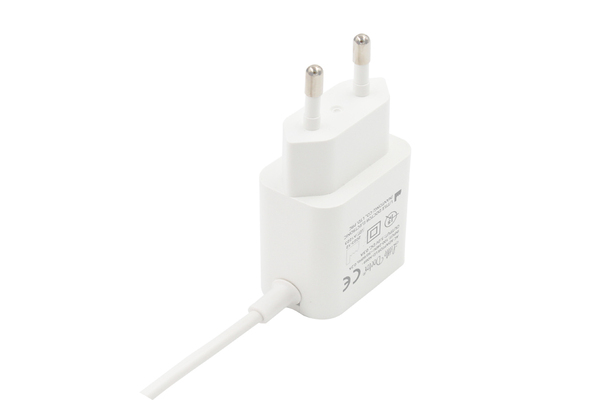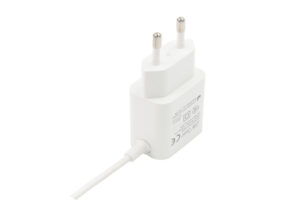Struggling with bulky, inefficient chargers? You’re not alone. As devices get smarter, power demands grow, leaving old adapters behind. We need better solutions, fast.
The power adapter market is booming, thanks to smart devices, EVs, and data centers. Key changes include smaller, more efficient designs using new materials like GaN and SiC, meeting demands for high performance and portability.
It’s clear that the world of power adapters is changing quickly. As a company deeply involved in designing and manufacturing these essential components, we at Quankang Technology have seen these shifts firsthand. Let me walk you through what’s driving this evolution and where we see things heading. It’s a fascinating journey, and understanding it can help everyone, from designers like Jacky to everyday users.
What’s Really Fueling the Surge in Power Adapter Demand?
Ever wonder why suddenly everyone needs a new, better charger? Old adapters can’t keep up. This explosive demand isn’t magic; specific powerful forces are at play, reshaping our industry.
The huge demand for power adapters comes from more consumer electronics like phones and tablets, the rise of electric vehicles, the expansion of data centers needing stable power, and countless new IoT devices.
I see these drivers impacting our work daily. For folks like Jacky, who design consumer electronics, the pressure is always on to integrate the best power solutions.
Consumer Electronics Boom
Smartphones, tablets, and wearables are everywhere. Each one needs a power adapter. And users want them small and efficient. We’ve had to innovate constantly to shrink sizes while boosting power. I remember when a client needed a 65W adapter the size of an old 30W one; it was a rewarding challenge to solve that with new component technologies.
Electric Vehicles Gaining Speed
The shift to electric vehicles (EVs) is another huge factor. EVs need robust on-board chargers and charging station adapters. These must be highly reliable and powerful, capable of handling significant energy safely and quickly. This segment demands durability and efficiency, pushing our engineering capabilities.
Data Centers’ Growing Appetite
Then there are data centers. With cloud computing and the Internet of Things expanding, these facilities are growing rapidly. They need incredibly stable and highly efficient power solutions. Power density here is crucial to optimize space and reduce energy consumption, which are major operational costs for data centers.
The Internet of Things (IoT) Explosion
Finally, IoT devices. From smart home gadgets to industrial sensors, billions of these tiny devices are connecting. Each needs power, often in compact, energy-sipping forms. This has opened up a whole new category for specialized, often custom-designed, adapters. It’s a lot to keep up with, but it’s an exciting field to be in.
| Driver | Key Adapter Requirement | Impact on Our Design Focus |
|---|---|---|
| Consumer Electronics | Miniaturization, Efficiency | Smaller, lighter, fast-charge capabilities |
| Electric Vehicles | High Power, Reliability | Robust, durable, high-density power conversion |
| Data Centers | Stability, High Efficiency | Energy-saving designs, maximal power density |
| IoT Devices | Low Power, Compactness | Small form factor, efficient standby modes |
This complex interplay of demands keeps us on our toes here at Quankang, constantly pushing us to develop smarter, more tailored power solutions for various applications.
What Hot New Trends Are Redefining Power Adapter Design?
Are you noticing chargers getting smaller yet more powerful? It’s frustrating when new tech makes old accessories seem obsolete. But these changes aren’t random; exciting new trends are making adapters better for everyone.
Key trends in power adapters include higher power density and smaller sizes, largely thanks to new materials like Gallium Nitride (GaN) and Silicon Carbide (SiC). There’s also a big push for better energy efficiency and multi-functional adapters.
We’re always excited to explore new trends at Quankang. These aren’t just buzzwords; they represent real improvements for users and new, interesting challenges for us designers.
Higher Power Density: Doing More with Less
One of the biggest shifts I’ve seen is the push for higher power density. This means getting more power out of a smaller physical package. New semiconductor materials like Gallium Nitride (GaN) and Silicon Carbide (SiC) are absolute game-changers here. They allow adapters to run cooler and much more efficiently, so we can significantly shrink them down. For product designers like Jacky, this means more flexibility in their overall product design.
Miniaturization and Lightweight: Power on the Go
Consumers today expect sleek, portable devices, and that expectation extends to their accessories. Bulky, heavy chargers are a major inconvenience. We’re constantly working on making our adapters smaller and lighter without sacrificing an ounce of performance. I recall a project where we successfully reduced an adapter’s total volume by 40% just by adopting GaN technology – the client was absolutely thrilled with the result.
Super Energy Efficiency: Saving Power, Saving Money
Energy conservation is a growing global concern. Government regulations are getting stricter, pushing for higher energy efficiency standards like DoE Level VI. We focus heavily on designs that minimize energy waste. This is not only good for the planet but also saves users money on their electricity bills over time.
Multifunctional Adapters: One Charger for All (or Most)
Most people own multiple electronic devices. Carrying a different charger for each one is a real pain. So, multifunctional power adapters that can charge various devices, perhaps with multiple output ports or supporting different fast-charging protocols and voltage standards, are becoming very popular. This is especially true for people who travel frequently. It’s all about enhancing convenience.
| Trend | Enabling Technology/Factor | Benefit to User |
|---|---|---|
| High Power Density | GaN, SiC materials, advanced magnetics | Smaller, more powerful, cooler chargers |
| Miniaturization/Lightweight | Advanced component integration, new topologies | Easier portability, sleeker product aesthetics |
| High Energy Efficiency | Stricter regulations (e.g., DOE VI), new ICs | Lower energy bills, eco-friendly operation |
| Multifunctional Adapters | USB-PD, PPS, smart ICs | Convenience, charges multiple devices with one unit |
These trends really push our team to innovate continuously. It’s not just about making a power adapter anymore; it’s about making it intelligent, compact, and exceptionally efficient.
What Obstacles Are We Facing in the Power Adapter Industry?
Think making power adapters is easy? It’s actually a very tough market. Rising material costs and rapid technological changes create constant pressure. We face significant hurdles to deliver the high-quality products you need.
The power adapter industry faces challenges like fluctuating raw material prices (copper, plastics), high barriers to technological innovation (especially with new materials like GaN), and intense market competition, particularly from large manufacturing hubs.
While the market is full of opportunities, it’s not without its headaches. We navigate these challenges daily to bring reliable and advanced power solutions to our clients.
The Rollercoaster of Raw Material Prices
One major issue that always keeps us on our toes is the price volatility of raw materials. Copper, aluminum, plastics, and even rare earth elements used in magnets – their costs can swing wildly due to global supply chains and economic factors. This directly impacts our production costs and margins. I remember one quarter when copper prices shot up unexpectedly, and our procurement team had to work incredibly hard to secure supply and mitigate that cost increase without immediately passing it all onto our customers. It forces us to be very smart and agile about sourcing and inventory management.
The High Bar of Technological Innovation
Keeping up with the relentless pace of technology is another big one. Power adapter technology, especially when it involves new materials like GaN and SiC, improving efficiency beyond current levels, and further shrinking physical sizes, isn’t simple. Research and Development in this area requires significant, sustained investment and specialized expertise. For smaller companies, this can be a major barrier. We at Quankang invest heavily in R&D because we believe it’s absolutely crucial for staying competitive and providing the best, most advanced components for clients like Jacky, who depend on cutting-edge technology for their own products.
Fierce Market Competition: Standing Out in a Crowd
The power adapter market is incredibly crowded. With so many manufacturers, especially in regions known for high-volume electronics production like China and other parts of Asia, competition is fierce. Price wars are unfortunately common. To succeed and thrive, you can’t just compete on price alone; you need to offer superior quality, genuine innovation, and exceptional service. We focus on building long-term, strong relationships with our clients and providing real, tangible value – not just selling a box. It’s about being a trusted partner, not just another supplier on a list.
| Challenge | Primary Impact Area | Our Mitigation Strategy at Quankang |
|---|---|---|
| Raw Material Price Volatility | Production Costs, Margins | Strategic sourcing, supply chain optimization, alternative material research |
| Tech Innovation Barriers | R&D Investment, Expertise | Continuous R&D funding, talent development, industry collaborations |
| Fierce Market Competition | Pricing Pressure, Differentiation | Focus on quality, innovation, customer service, value-added solutions |
Overcoming these challenges successfully requires resilience, sharp strategic planning, and an unwavering commitment to continuous improvement across all aspects of our business. It’s what we strive for every day.
What’s on the Horizon for Power Adapter Technology and the Market?
Curious about what your next charger will be able to do? Old technology fades quickly in this field. The future of power adapters is exciting, with smart innovations on the way that promise even better performance and convenience.
The future for power adapters looks bright, with continued strong growth expected. Expect more efficient, durable, and incredibly compact adapters using Gallium Nitride (GaN) and Silicon Carbide (SiC). Modular and multi-functional designs for IoT, plus Artificial Intelligence in power management, are key upcoming trends.
Looking ahead, I’m genuinely optimistic about where power adapter technology is going. We’re on the cusp of some truly exciting developments at Quankang, and I believe we’ll see significant leaps forward.
Continued Strong Growth and Advanced Materials
The market will undoubtedly keep growing. A big part of this future growth will be driven by the wider adoption and maturation of wide-bandgap semiconductor materials like Gallium Nitride (GaN) and Silicon Carbide (SiC). We’ve already seen how these materials can dramatically improve efficiency, increase power density, and reduce heat generation. This means even smaller, more powerful, and more durable adapters are coming. I envision a future where a single, remarkably tiny adapter can efficiently power multiple high-demand devices.
IoT, Modularity, and Enhanced Multifunctionality
As the Internet of Things (IoT) continues its explosive expansion, the need for specialized, often modular, power solutions will increase significantly. Think of power adapters that can be easily integrated into diverse IoT devices or customized for very specific application requirements. Multifunctional adapters will also become even more sophisticated and standard, offering greater convenience and reducing electronic waste.
The Rise of AI in Power Management
This is an area I find particularly fascinating and full of potential: the integration of Artificial Intelligence (AI) into power management systems. Imagine power adapters that can learn your typical usage patterns and intelligently optimize power delivery for maximum efficiency and improved battery health for your devices. AI algorithms could fine-tune energy consumption in real-time, adapting to changing loads and conditions. This could revolutionize how we think about power, making entire systems smarter and more responsive. For product designers like Jacky, this opens up a wealth of new possibilities for creating truly intelligent and interconnected device ecosystems.
| Future Trend | Key Technology/Driver | Expected Benefit for Users & Industry |
|---|---|---|
| Advanced Material Adoption | GaN, SiC proliferation, new magnetics | Smaller, faster, cooler, more efficient chargers |
| IoT & Modular Designs | Growth of connected devices, edge computing | Customizable, integrated, application-specific power |
| AI in Power Management | Machine learning algorithms, smart ICs | Intelligent energy optimization, improved battery life, predictive maintenance |
The next few years are set to be transformative for our industry. It’s a fantastic time to be innovating in power solutions, and we are excited to be part of that journey.
Conclusion
The power adapter market is dynamic, offering huge opportunities alongside tough challenges. Innovation, quality, and a focus on customer needs are key to leading the way forward.









